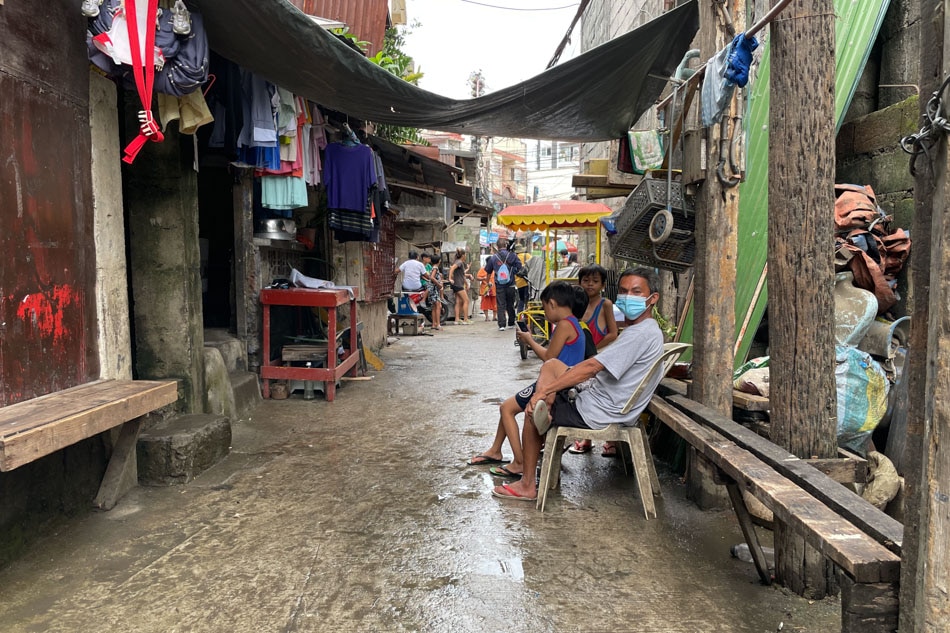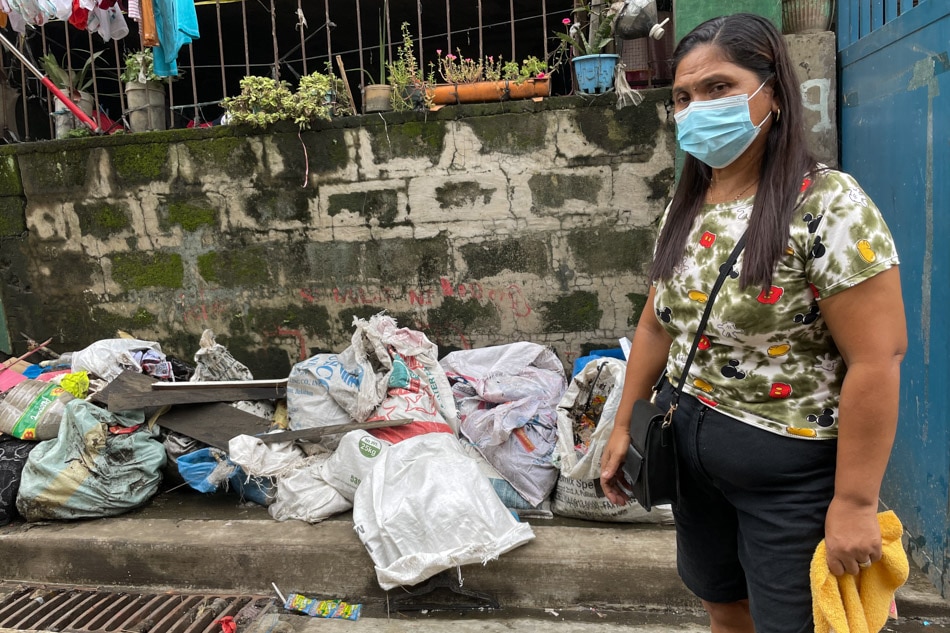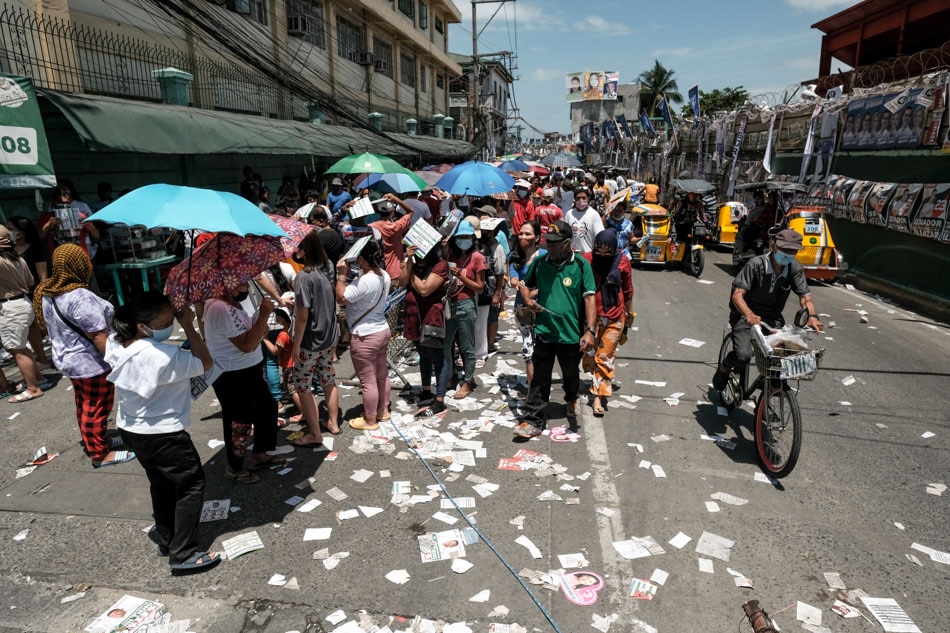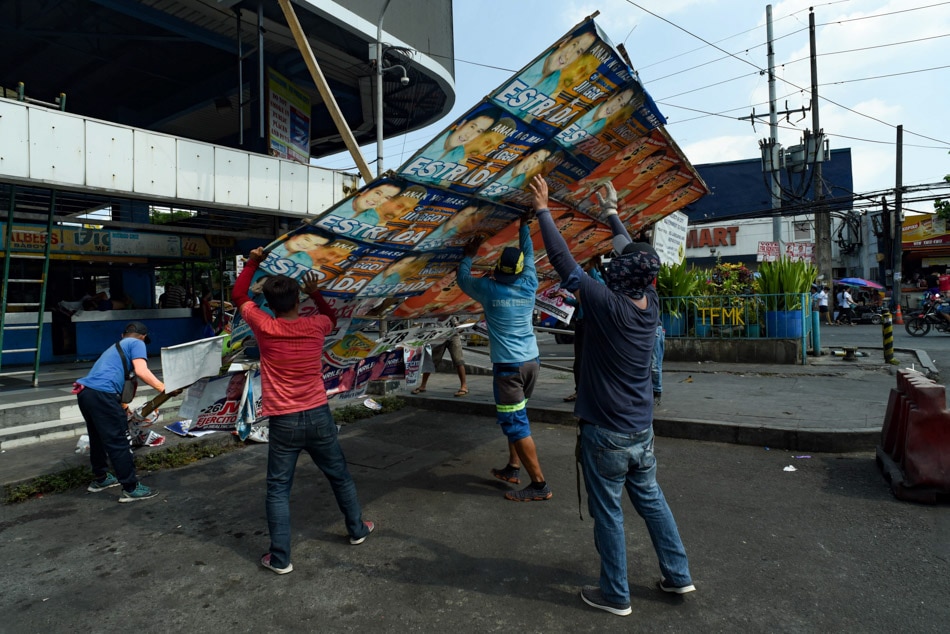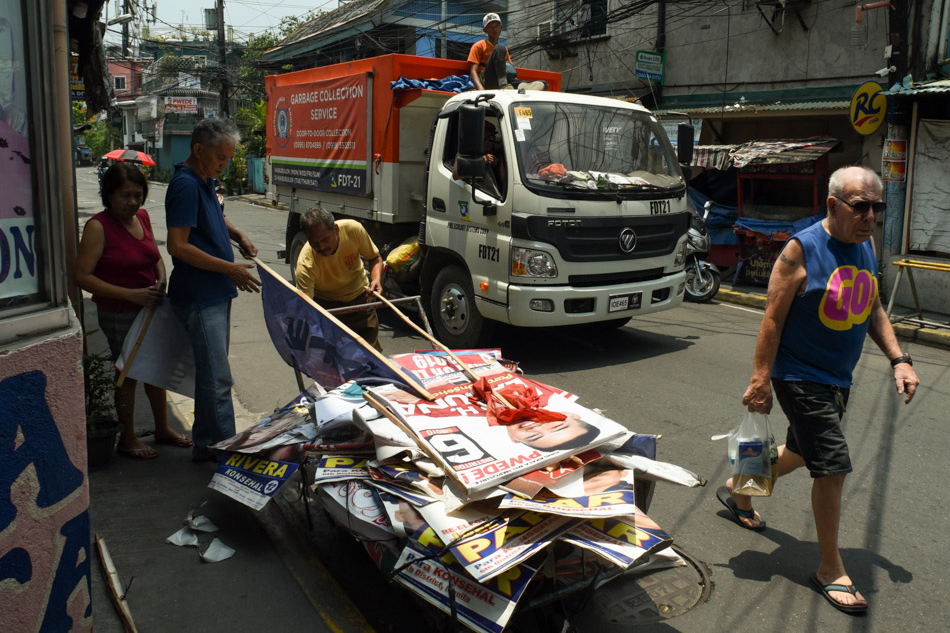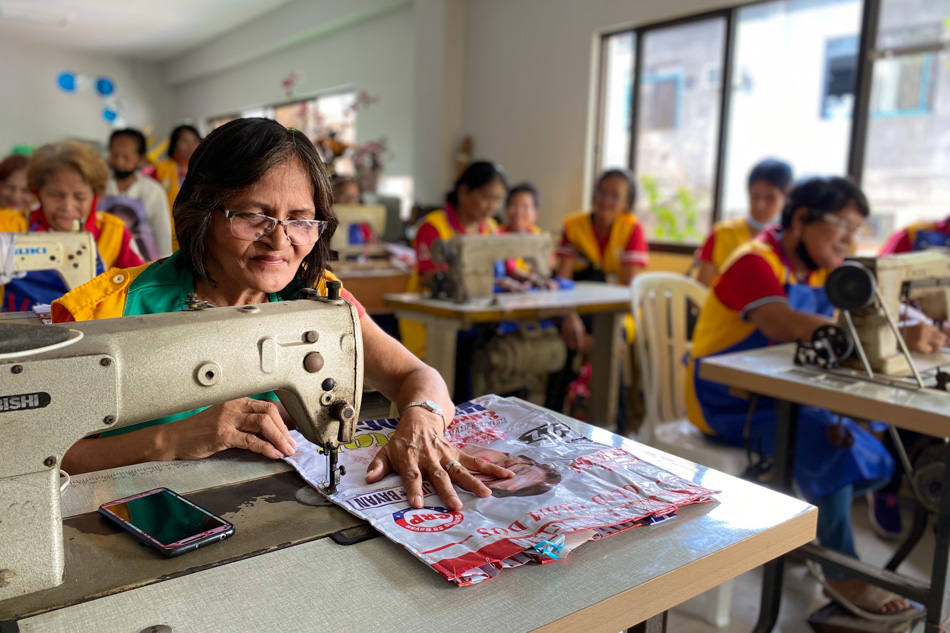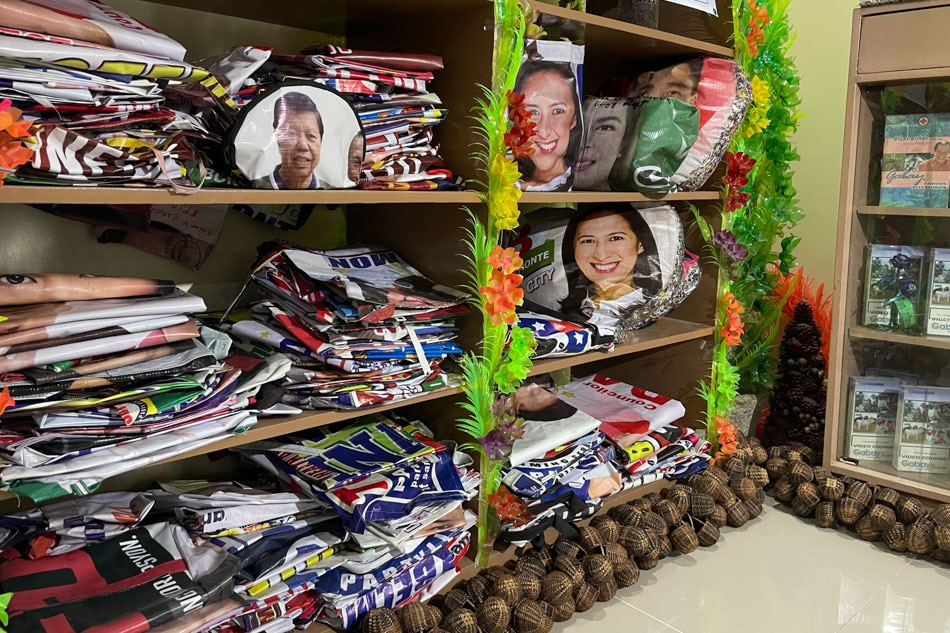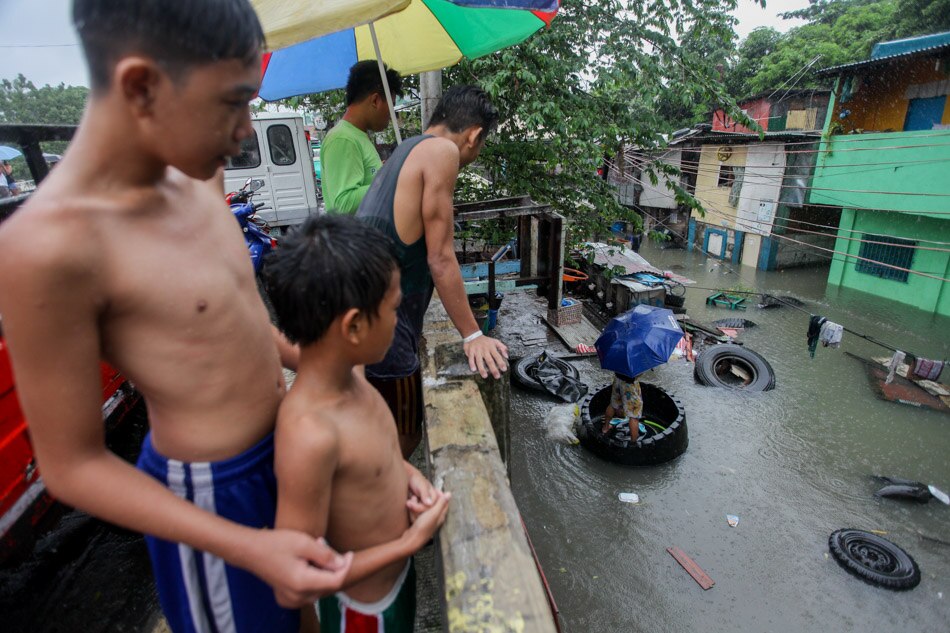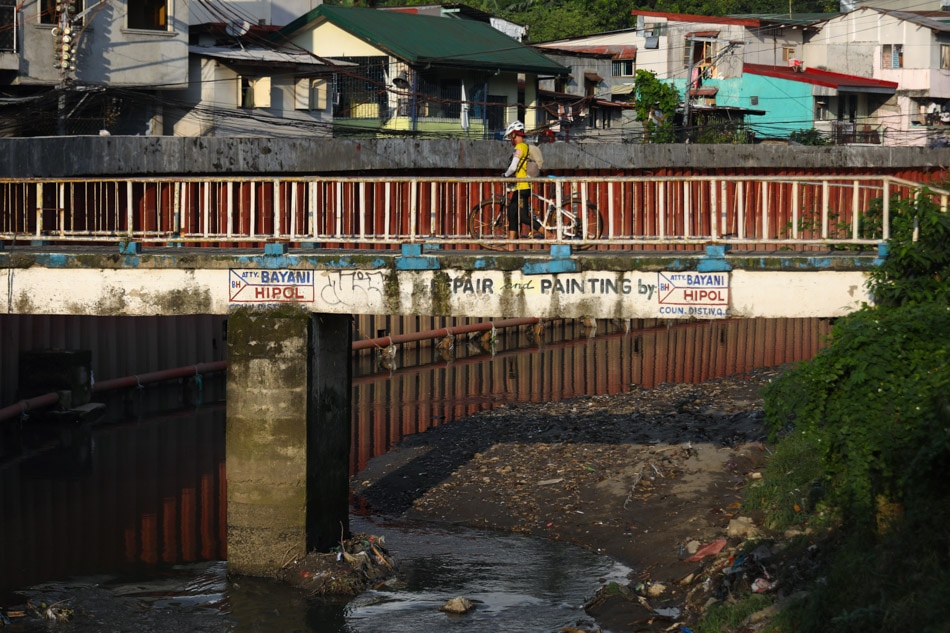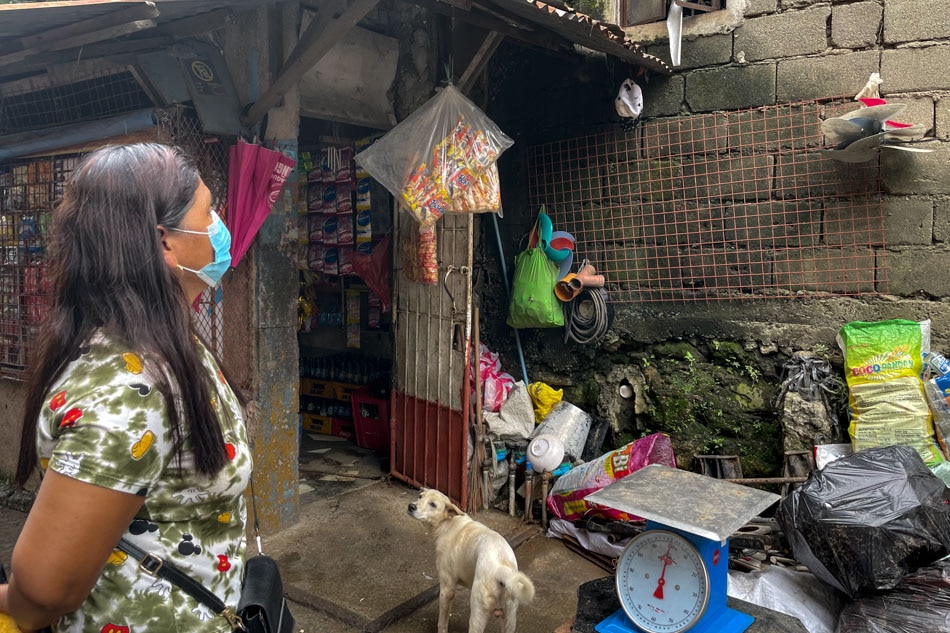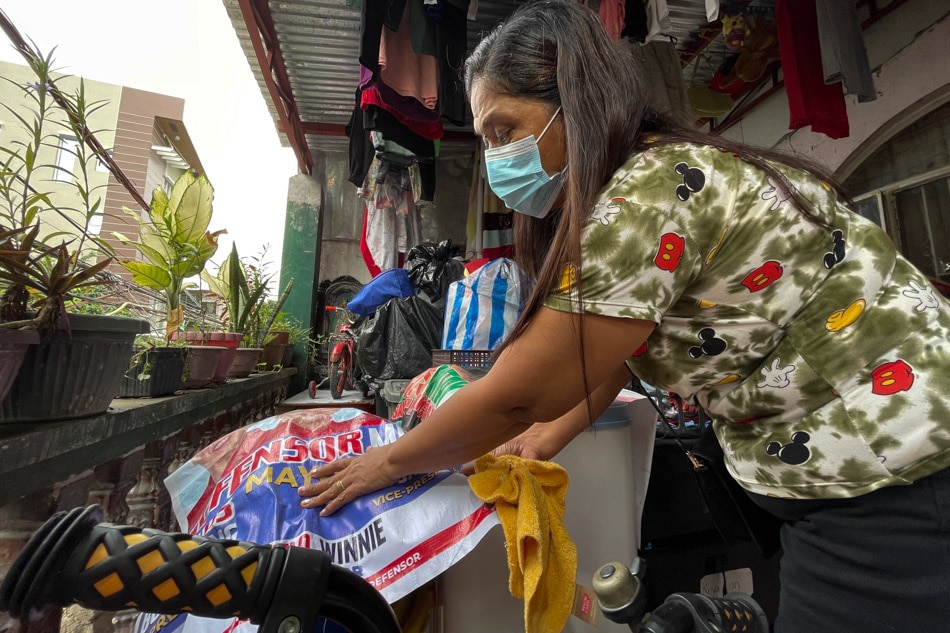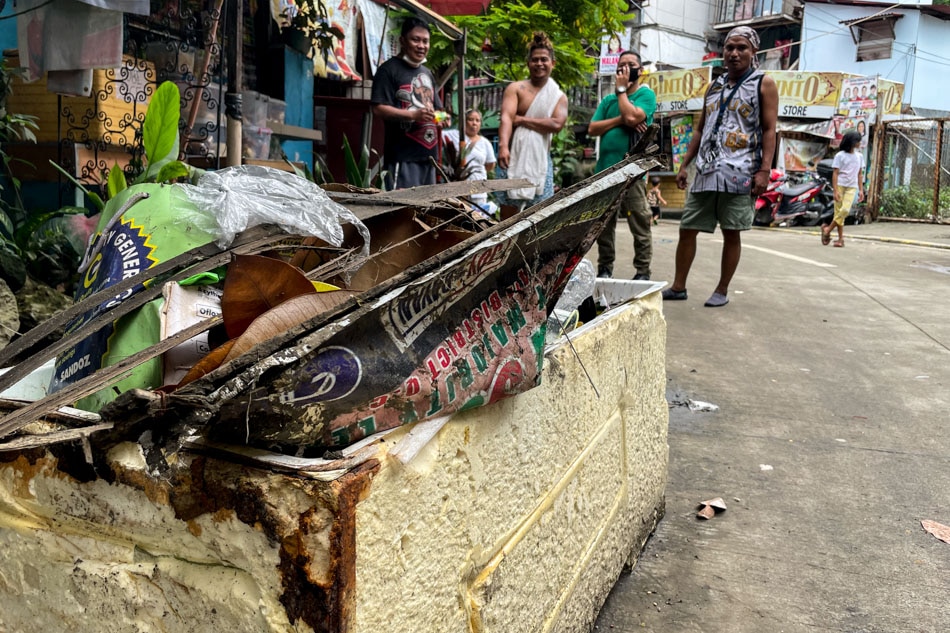The trash Philippine elections produce, and its long-term effects | ABS-CBN

Welcome, Kapamilya! We use cookies to improve your browsing experience. Continuing to use this site means you agree to our use of cookies. Tell me more!
The trash Philippine elections produce, and its long-term effects
The trash Philippine elections produce, and its long-term effects
Raphael Bosano,
ABS-CBN News
Published Nov 24, 2022 06:20 PM PHT
|
Updated Nov 29, 2022 09:53 AM PHT
Once every three years, candidates seeking public office make their presence felt the most. Aside from jingles that mimic the latest pop hits, one of the most popular means of leaving a mark on voters is through physical campaign paraphernalia. Sadly, its effects span way beyond their intended years to serve.
The flash of lightning stunned her.
The flash of lightning stunned her.
For a good couple of seconds, Cynthia Ludovice could not do anything else but crouch to the ground, her eyes shut tight while waiting for the rumbling to reach a crescendo. What followed was a chorus of patterns against everything she could see.
For a good couple of seconds, Cynthia Ludovice could not do anything else but crouch to the ground, her eyes shut tight while waiting for the rumbling to reach a crescendo. What followed was a chorus of patterns against everything she could see.
There had already been countless thunderstorms before this. It is, after all, the rainy season, an unpopular time of the year in their small community.
There had already been countless thunderstorms before this. It is, after all, the rainy season, an unpopular time of the year in their small community.
From her vantage point, a veranda on the second floor of a rented home in Quezon City, the street below her slowly disappeared.
From her vantage point, a veranda on the second floor of a rented home in Quezon City, the street below her slowly disappeared.
ADVERTISEMENT
Gumamela Street in Barangay Roxas District has gained attention throughout the years by building a reputation for flooding at seven feet, at times even higher.
Gumamela Street in Barangay Roxas District has gained attention throughout the years by building a reputation for flooding at seven feet, at times even higher.
It’s a scene she’s become all too familiar with.
It’s a scene she’s become all too familiar with.
Working as a street sweeper in the community, Ludovice is thankful that at a time when many continue to be out of work, she is able to earn a living from the litter caused by others. But it also has its costs.
Working as a street sweeper in the community, Ludovice is thankful that at a time when many continue to be out of work, she is able to earn a living from the litter caused by others. But it also has its costs.
“Every day po ako nagwawalis sa area ko. Every day ako naii-stress. Bakit? Bakit? Sabi ko, bakit laging ganito? Eh lagi namang pinapaalahanan. Wala na ba silang mga konsensya na bakit inilalabas ng maling oras,” she laments.
“Every day po ako nagwawalis sa area ko. Every day ako naii-stress. Bakit? Bakit? Sabi ko, bakit laging ganito? Eh lagi namang pinapaalahanan. Wala na ba silang mga konsensya na bakit inilalabas ng maling oras,” she laments.
(I clean the area assigned to me every day which also stresses me. I always ask myself why? Why is it always like this when we always remind them to be more responsible? Do they really have no conscience?)
(I clean the area assigned to me every day which also stresses me. I always ask myself why? Why is it always like this when we always remind them to be more responsible? Do they really have no conscience?)
Ludovice says residents have become used to bringing out their garbage at night even if the scheduled time of collection is not until the following morning. Knowing what most likely will happen to exposed and unattended garbage bags, she says, is not rocket science.
Ludovice says residents have become used to bringing out their garbage at night even if the scheduled time of collection is not until the following morning. Knowing what most likely will happen to exposed and unattended garbage bags, she says, is not rocket science.
“Tatangayin nang tatangayin na yan ng mga asong gala. Syempre magkakalat na yan lalo na pag may mga kaning baboy. May mga papel, plastic tapos minsan malalaki pang basura. Actually, kadalasan diaper na may mga poo-poo kinakalat din ng mga hayop.”
“Tatangayin nang tatangayin na yan ng mga asong gala. Syempre magkakalat na yan lalo na pag may mga kaning baboy. May mga papel, plastic tapos minsan malalaki pang basura. Actually, kadalasan diaper na may mga poo-poo kinakalat din ng mga hayop.”
(The garbage will be scattered by stray animals, including leftover food. There’s paper, plastic and other types, sometimes big garbage. Used diapers are also usually scattered by animals.)
(The garbage will be scattered by stray animals, including leftover food. There’s paper, plastic and other types, sometimes big garbage. Used diapers are also usually scattered by animals.)
This, together with torrential rain, is a recipe for something they’ve always dreaded.
This, together with torrential rain, is a recipe for something they’ve always dreaded.
She had no idea that the rain that evening, brought by the southwest monsoon, would cause flooding which would once again ignite her fears. While they already know, through years of experience, what to do during flash floods, panic has become an inevitably constant feeling. And while the adrenaline rush usually drives them to safety, it’s always the aftermath that makes them feel hollow.
She had no idea that the rain that evening, brought by the southwest monsoon, would cause flooding which would once again ignite her fears. While they already know, through years of experience, what to do during flash floods, panic has become an inevitably constant feeling. And while the adrenaline rush usually drives them to safety, it’s always the aftermath that makes them feel hollow.
“Siyempre ang kapal ng putik diyan. ‘Yung mga basura po naiwan diyan kasi wala naman po naglilinis gawa ng siyempre yung iba tulog. Ang naiwan po na basura katakot-takot at ang kapal ng putik. Sobrang baho ng putik.”
“Siyempre ang kapal ng putik diyan. ‘Yung mga basura po naiwan diyan kasi wala naman po naglilinis gawa ng siyempre yung iba tulog. Ang naiwan po na basura katakot-takot at ang kapal ng putik. Sobrang baho ng putik.”
(The mud left behind by the floods is thick. There’s also garbage that is left scattered because a lot of people are still asleep. The mud reeks.)
(The mud left behind by the floods is thick. There’s also garbage that is left scattered because a lot of people are still asleep. The mud reeks.)
Aside from the usual single-use plastic, food wrappings, drink containers, and cartons left strewn by receding floods, tarpaulins in various sizes are also seen mixed in a pile of garbage, mud, and debris.
Aside from the usual single-use plastic, food wrappings, drink containers, and cartons left strewn by receding floods, tarpaulins in various sizes are also seen mixed in a pile of garbage, mud, and debris.
It is most common now, especially after the country’s national elections that were held last May.
It is most common now, especially after the country’s national elections that were held last May.
ELECTION PARAPHERNILE-UP
May 9 was the day Filipinos exercised their right to suffrage. Unfortunately, it’s also the day when the environment suffers, when waste generation seems to be at its peak.
May 9 was the day Filipinos exercised their right to suffrage. Unfortunately, it’s also the day when the environment suffers, when waste generation seems to be at its peak.
Walking through streets that lead to polling places undoubtedly distorts the sense of normalcy as far as the visual order of things is concerned.
Walking through streets that lead to polling places undoubtedly distorts the sense of normalcy as far as the visual order of things is concerned.
While the Philippines, especially the highly-congested cities in its capital region, is not the tidiest place one can live in, there have been efforts made by local governments to manage waste generation let alone indiscriminate littering.
While the Philippines, especially the highly-congested cities in its capital region, is not the tidiest place one can live in, there have been efforts made by local governments to manage waste generation let alone indiscriminate littering.
But at a time when politicians, even those incumbent and seeking re-election, are too preoccupied and tensed in waiting for what the elections may birth, months and years' worth of efforts to mitigate the problem of waste generation can easily be sidetracked.
But at a time when politicians, even those incumbent and seeking re-election, are too preoccupied and tensed in waiting for what the elections may birth, months and years' worth of efforts to mitigate the problem of waste generation can easily be sidetracked.
In a polling place in Quezon City, flyers, sample ballots, fans, posters, tarpaulins, and other election paraphernalia bearing the names of aspiring public servants already filled the streets within minutes after the poll’s commencement. It would only take minutes before they were trampled upon by the never-ending flock of voters throughout the day, covered in slick and dirt and later on replaced by newly discarded election waste.
In a polling place in Quezon City, flyers, sample ballots, fans, posters, tarpaulins, and other election paraphernalia bearing the names of aspiring public servants already filled the streets within minutes after the poll’s commencement. It would only take minutes before they were trampled upon by the never-ending flock of voters throughout the day, covered in slick and dirt and later on replaced by newly discarded election waste.
Campaign volunteers would walk around a polling place, give out several pieces of sample ballots and other paraphernalia to voters before moving on to the next group of individuals and do the same thing. While they may be successful at making some take a second look, what usually happens is that these are either turned into makeshift fan to relieve a voter from heat or they are simply held onto.
Campaign volunteers would walk around a polling place, give out several pieces of sample ballots and other paraphernalia to voters before moving on to the next group of individuals and do the same thing. While they may be successful at making some take a second look, what usually happens is that these are either turned into makeshift fan to relieve a voter from heat or they are simply held onto.
Either way, after an individual has cast a vote, the campaign materials they hold end up being chucked to the ground. This entire process of distributing and mindless tossing happens throughout the day in polling places around the country.
Either way, after an individual has cast a vote, the campaign materials they hold end up being chucked to the ground. This entire process of distributing and mindless tossing happens throughout the day in polling places around the country.
While some areas do better at managing it (or perhaps some people are more conscious and disciplined) others are not as keen. The result is streets flooded with paper, cardboard, and even food waste that come in different shapes and sizes. After all, election day in the Philippines is a golden opportunity for food vendors to take their positions and earn a living in the midst of the hustle of determining the country’s future.
While some areas do better at managing it (or perhaps some people are more conscious and disciplined) others are not as keen. The result is streets flooded with paper, cardboard, and even food waste that come in different shapes and sizes. After all, election day in the Philippines is a golden opportunity for food vendors to take their positions and earn a living in the midst of the hustle of determining the country’s future.
Some have resorted to calling them election paraphrenile-up – a play with words pertaining to the pile-up of election-related garbage.
Some have resorted to calling them election paraphrenile-up – a play with words pertaining to the pile-up of election-related garbage.
According to environment watchdog Ecowaste Coalition, the Philippines generates more trash during election years.
According to environment watchdog Ecowaste Coalition, the Philippines generates more trash during election years.
In the 2016 national elections, 206 tons of garbage were generated and collected. This decreased slightly to a little over 200 tons during the midterm elections in 2019.
In the 2016 national elections, 206 tons of garbage were generated and collected. This decreased slightly to a little over 200 tons during the midterm elections in 2019.
But this year, collected garbage from elections is 254 tons or around 20% higher compared to the 2016 national elections.
But this year, collected garbage from elections is 254 tons or around 20% higher compared to the 2016 national elections.
The accumulation of trash, especially in large volumes at any given time is without a doubt disastrous for any community.
The accumulation of trash, especially in large volumes at any given time is without a doubt disastrous for any community.
“Hindi kasi natutunaw yung mga tarpaulins. Hindi siya biodegradable. Pag na-mismanage yung pag handle, nagiging cause din siya ng pagbara. Kung liliparin lang siya or hindi properly na naitapon, magiging cause yan ng pagbara sa mga kanal. Nagiging water waste din siya,” says waste specialist Everly Joy Sarmiento.
“Hindi kasi natutunaw yung mga tarpaulins. Hindi siya biodegradable. Pag na-mismanage yung pag handle, nagiging cause din siya ng pagbara. Kung liliparin lang siya or hindi properly na naitapon, magiging cause yan ng pagbara sa mga kanal. Nagiging water waste din siya,” says waste specialist Everly Joy Sarmiento.
(Tarpaulins don’t break down. It’s non-biodegradable so if it’s not properly handled, like letting it be blown by the wind or simply throwing it out, it can clog up sewers. It also becomes water waste.)
(Tarpaulins don’t break down. It’s non-biodegradable so if it’s not properly handled, like letting it be blown by the wind or simply throwing it out, it can clog up sewers. It also becomes water waste.)
But the use of tarpaulins and other such materials to woo the electorate is not prohibited. In fact, pamphlets, leaflets, cards, stickers, paper, cloth, and even cardboard posters, as long as it follows the right size, are considered lawful election propaganda, based on the Fair Elections Act.
But the use of tarpaulins and other such materials to woo the electorate is not prohibited. In fact, pamphlets, leaflets, cards, stickers, paper, cloth, and even cardboard posters, as long as it follows the right size, are considered lawful election propaganda, based on the Fair Elections Act.
However, the Commission on Elections also issued a resolution in late 2021 which doesn’t require but rather encourages parties and candidates to use “recyclable and environment-friendly materials and avoid those that contain hazardous chemicals and substances in the production of their campaign and election propaganda.”
However, the Commission on Elections also issued a resolution in late 2021 which doesn’t require but rather encourages parties and candidates to use “recyclable and environment-friendly materials and avoid those that contain hazardous chemicals and substances in the production of their campaign and election propaganda.”
“In local government units where local legislation governing the use of plastic and other similar materials exist, parties and candidates shall comply with the same,” the resolution read.
“In local government units where local legislation governing the use of plastic and other similar materials exist, parties and candidates shall comply with the same,” the resolution read.
While posters should only be put up in common poster areas, it is still allowed for candidates to post their propaganda materials in private places provided that the owners give their consent. The result – a gallery of different faces that span an alleyway, residential and establishment gates bearing posters of their preferred candidates. Add on to this campaign volunteers who house-hop while distributing flyers and other campaign materials. This image is seen in different parts of the country all at the same time.
While posters should only be put up in common poster areas, it is still allowed for candidates to post their propaganda materials in private places provided that the owners give their consent. The result – a gallery of different faces that span an alleyway, residential and establishment gates bearing posters of their preferred candidates. Add on to this campaign volunteers who house-hop while distributing flyers and other campaign materials. This image is seen in different parts of the country all at the same time.
Four months' worth of campaign materials including last-minute distributions on election day yielded 206 tons of waste.
Four months' worth of campaign materials including last-minute distributions on election day yielded 206 tons of waste.
While environmental advocates, civil society groups, and even some local governments already have a solution for these kinds of waste, it still cannot be denied that the most vulnerable communities continue to be at risk, especially during extreme weather. These risks are further fuelled by non-biodegradable and improperly managed waste.
While environmental advocates, civil society groups, and even some local governments already have a solution for these kinds of waste, it still cannot be denied that the most vulnerable communities continue to be at risk, especially during extreme weather. These risks are further fuelled by non-biodegradable and improperly managed waste.
USING THE USELESS
A day after the polls, the Metropolitan Manila Development Authority and local governments immediately began collecting remnants of the election fever. Pieces of paper of what used to be flyers as well as wet and worn-out cardboard among others filled communal garbage bins. Posters and tarpaulins were also taken down and disposed of.
A day after the polls, the Metropolitan Manila Development Authority and local governments immediately began collecting remnants of the election fever. Pieces of paper of what used to be flyers as well as wet and worn-out cardboard among others filled communal garbage bins. Posters and tarpaulins were also taken down and disposed of.
But unlike years past, a lot of these will not be left idle in bins or landfills.
But unlike years past, a lot of these will not be left idle in bins or landfills.
Different groups all over the country worked in mustering those that are still in good condition and could be used for a different purpose.
Different groups all over the country worked in mustering those that are still in good condition and could be used for a different purpose.
Youth groups in provinces transformed tarpaulins into something more usable while others turned them into thought-provoking artwork.
Youth groups in provinces transformed tarpaulins into something more usable while others turned them into thought-provoking artwork.
Months after the polls, some women of Barangay Holy Spirit in Quezon City remain busy making new creations from what would seem as useless pieces of election garbage just a few years ago.
Months after the polls, some women of Barangay Holy Spirit in Quezon City remain busy making new creations from what would seem as useless pieces of election garbage just a few years ago.
Strutting the aisles between tables and glancing from one set of hands to another is Lydia Pedernal, head of the barangay’s livelihood department. At 79, she continues to look after their community’s environment – making sure that in their own little way, waste is mitigated especially in flood-prone areas.
Strutting the aisles between tables and glancing from one set of hands to another is Lydia Pedernal, head of the barangay’s livelihood department. At 79, she continues to look after their community’s environment – making sure that in their own little way, waste is mitigated especially in flood-prone areas.
Every day her team of workers occupies a small portion of the multipurpose hall, their eyes laser-focused on the task at hand. All of them are mothers who earn just enough from their intricately handcrafted products made from what others would normally regard as junk.
Every day her team of workers occupies a small portion of the multipurpose hall, their eyes laser-focused on the task at hand. All of them are mothers who earn just enough from their intricately handcrafted products made from what others would normally regard as junk.
Their products range from table ornaments made from soda bottles, bags, baskets, and file organizers entirely made from either drinking straws (used but disinfected) or paper.
Their products range from table ornaments made from soda bottles, bags, baskets, and file organizers entirely made from either drinking straws (used but disinfected) or paper.
“Sabi nila there is gold in garbage. Kaya tinuturan namin ang mga tao na talagang gumawa ng mga produkto na pwede nating ibenta. Lalo na yung mga walang hanapbuhay,” Pedernal explains.
“Sabi nila there is gold in garbage. Kaya tinuturan namin ang mga tao na talagang gumawa ng mga produkto na pwede nating ibenta. Lalo na yung mga walang hanapbuhay,” Pedernal explains.
(They say that in the garbage, there is gold. That’s why we teach people to make products that can be sold. We teach those who really have no source of livelihood.)
(They say that in the garbage, there is gold. That’s why we teach people to make products that can be sold. We teach those who really have no source of livelihood.)
On this particular day, some have just finished upcycling and repurposing tarpaulins of different candidates in the recently concluded elections. These, to her, are the most widely-used material followed by smaller election paraphernalia.
On this particular day, some have just finished upcycling and repurposing tarpaulins of different candidates in the recently concluded elections. These, to her, are the most widely-used material followed by smaller election paraphernalia.
“Sa buong mundo, nagkakaroon tayo ng mga problema on how to mitigate climate change. Ang baha, halos hindi ma-control. Maraming bahay ang lumulubog, maraming sasakyan ang nasisira. So talagang dapat matutunan ng mga tao ang paghihiwalay-hiwalay ng mga basura na pwede pa nating magawang produkto, na pwedeng magamit sa bahay o pwedeng ma-ibenta.”
“Sa buong mundo, nagkakaroon tayo ng mga problema on how to mitigate climate change. Ang baha, halos hindi ma-control. Maraming bahay ang lumulubog, maraming sasakyan ang nasisira. So talagang dapat matutunan ng mga tao ang paghihiwalay-hiwalay ng mga basura na pwede pa nating magawang produkto, na pwedeng magamit sa bahay o pwedeng ma-ibenta.”
(The entire world is experiencing problems in terms of mitigating climate change. Floods cannot be controlled. Homes become submerged, and vehicles are destroyed. So it’s really important for people to learn how to segregate useless garbage from those that can still be made into different products and later sold.)
(The entire world is experiencing problems in terms of mitigating climate change. Floods cannot be controlled. Homes become submerged, and vehicles are destroyed. So it’s really important for people to learn how to segregate useless garbage from those that can still be made into different products and later sold.)
In their barangay, a lot of the tarpaulin are turned into aprons. She says these are very useful not only for mothers who tend their small eateries but also those who work in wet markets. Others are turned into reusable bags which have become especially handy now that a lot of establishments have ditched single-use plastic over eco-friendly carriers.
In their barangay, a lot of the tarpaulin are turned into aprons. She says these are very useful not only for mothers who tend their small eateries but also those who work in wet markets. Others are turned into reusable bags which have become especially handy now that a lot of establishments have ditched single-use plastic over eco-friendly carriers.
However, some argue about whether or not such a move really provides a solution or is just actually delaying the problem. Like all things, tarpaulins repurposed as carriers or aprons are also subject to wear and tear. The question is, what happens to them when they can no longer bear the brunt?
However, some argue about whether or not such a move really provides a solution or is just actually delaying the problem. Like all things, tarpaulins repurposed as carriers or aprons are also subject to wear and tear. The question is, what happens to them when they can no longer bear the brunt?
“Puwede naman siya magamit like yung mga eco bags, we can use that naman. But it’s temporary, na ma-extend yung buhay nila. But at the end of the day, waste pa rin siya na maituturing,” Sarmiento explains.
“Puwede naman siya magamit like yung mga eco bags, we can use that naman. But it’s temporary, na ma-extend yung buhay nila. But at the end of the day, waste pa rin siya na maituturing,” Sarmiento explains.
(Yes they can be used as eco bags. But it’s just a temporary fix. At the end of the day, it is still considered waste.)
(Yes they can be used as eco bags. But it’s just a temporary fix. At the end of the day, it is still considered waste.)
Sarmiento adds the lifecycle of a tarpaulin, even if its function can no longer be salvaged, takes an awful lot of years before it actually disintegrates. And the chances of it ending up lying around in a landfill is really high.
Sarmiento adds the lifecycle of a tarpaulin, even if its function can no longer be salvaged, takes an awful lot of years before it actually disintegrates. And the chances of it ending up lying around in a landfill is really high.
Whether or not this is the case, for Pedernal, it’s better than just letting them clog drainage systems and aggravate flooding even more. In fact, recycling garbage has brought forth camaraderie among members of the community. It also brings with it the opportunity to educate people about environmental problems they will most likely encounter.
Whether or not this is the case, for Pedernal, it’s better than just letting them clog drainage systems and aggravate flooding even more. In fact, recycling garbage has brought forth camaraderie among members of the community. It also brings with it the opportunity to educate people about environmental problems they will most likely encounter.
“We just dont manage the garbage, but we also generate jobs. Dahil yung mga livelihood activities, may income generation yan. Dagdag kita nga ang tawag namin. It cannot be the main source of income for the family, pero nakakabigay ng dagdag at nakakapagsave ng expenses,” Pedernal says.
“We just dont manage the garbage, but we also generate jobs. Dahil yung mga livelihood activities, may income generation yan. Dagdag kita nga ang tawag namin. It cannot be the main source of income for the family, pero nakakabigay ng dagdag at nakakapagsave ng expenses,” Pedernal says.
(Livelihood activities are income generating. It gives them additional income. It cannot be their main source of income but it adds resources to growing expenses.)
(Livelihood activities are income generating. It gives them additional income. It cannot be their main source of income but it adds resources to growing expenses.)
Pedernal admits that while the use of tarpaulin has undeniable repercussions for the environment and vulnerable communities, it also has its benefits especially for a mother wanting to provide a little bit more for her family.
Pedernal admits that while the use of tarpaulin has undeniable repercussions for the environment and vulnerable communities, it also has its benefits especially for a mother wanting to provide a little bit more for her family.
“We find it profitable kaya I will not really support the suspension or discontinuance of tarpaulin as a way of introducing the politicians to the people.”
“We find it profitable kaya I will not really support the suspension or discontinuance of tarpaulin as a way of introducing the politicians to the people.”
(We find it profitable which is why I will not really support the suspension or discontinuance of tarpaulins as a way of introducing politicians to people.)
(We find it profitable which is why I will not really support the suspension or discontinuance of tarpaulins as a way of introducing politicians to people.)
Ironic as it may sound, for her, the best they can do is teach their community about the devastating effects of the harsh reality of improper waste management.
Ironic as it may sound, for her, the best they can do is teach their community about the devastating effects of the harsh reality of improper waste management.
Data from the Philippine Statistics Authority show that as of June 30, 2022, the Philippines has a total of over 42,000 barangays. If each barangay will generate a sizeable amount of election-related trash and then not manage it properly, Pedernal sees the Philippines is not only submerged in flood, but in the trash. What happens after does not need much pondering.
Data from the Philippine Statistics Authority show that as of June 30, 2022, the Philippines has a total of over 42,000 barangays. If each barangay will generate a sizeable amount of election-related trash and then not manage it properly, Pedernal sees the Philippines is not only submerged in flood, but in the trash. What happens after does not need much pondering.
“So it’s also a health hazard if you don’t manage the waste properly. We would get all kinds of diseases. We’re already experiencing it now, why would we want our children and grandchildren to go through it?”
“So it’s also a health hazard if you don’t manage the waste properly. We would get all kinds of diseases. We’re already experiencing it now, why would we want our children and grandchildren to go through it?”
At a time when social media has relatively succeeded in taking over traditional platforms, the Ecowaste Coalition believes, it is still possible for candidates to run and succeed without having to contribute excessively to election campaign waste. After tracking candidates and their campaigns, Sarmiento says one senatorial candidate was actually successful in winning a seat despite an eco-friendly campaign.
At a time when social media has relatively succeeded in taking over traditional platforms, the Ecowaste Coalition believes, it is still possible for candidates to run and succeed without having to contribute excessively to election campaign waste. After tracking candidates and their campaigns, Sarmiento says one senatorial candidate was actually successful in winning a seat despite an eco-friendly campaign.
“Naniniwala ako na ngayon, mas mulat yung mga tao sa impact ng basura. Mas tinitignan na nila yung unang plataporma ng kandidato ay basura. Kung paninindigan lang ng kanditato yung pag lessen ng basura at ipapakita niya talaga na pwedeng manalo, I think mananalo naman,” Sarmeinto says.
“Naniniwala ako na ngayon, mas mulat yung mga tao sa impact ng basura. Mas tinitignan na nila yung unang plataporma ng kandidato ay basura. Kung paninindigan lang ng kanditato yung pag lessen ng basura at ipapakita niya talaga na pwedeng manalo, I think mananalo naman,” Sarmeinto says.
(I believe that people now are more aware of the impact of trash. They now look at whether waste management is part of a candidate’s platform. If only a candidate would really stand by it, I think they would be successful in their bid.)
(I believe that people now are more aware of the impact of trash. They now look at whether waste management is part of a candidate’s platform. If only a candidate would really stand by it, I think they would be successful in their bid.)
Pedernal may be in her twilight years but her energy in teaching fellow mothers on the importance and value of recycling still seems like it’s a newfound love. Her only hope is that the learnings are passed on to the next generation with the same level of passion. The value of their works is, after all, beyond just any monetary amount. More important than this, prevents their community from drowning after a continuously heavy downpour.
Pedernal may be in her twilight years but her energy in teaching fellow mothers on the importance and value of recycling still seems like it’s a newfound love. Her only hope is that the learnings are passed on to the next generation with the same level of passion. The value of their works is, after all, beyond just any monetary amount. More important than this, prevents their community from drowning after a continuously heavy downpour.
SMALL STEPS
In her small office, Maria Carmela Gotladera, the chief of Barangay Roxas District, sits behind a desk cluttered with paperwork. She looks intently at a map of her barangay that is highlighted in different colors.
In her small office, Maria Carmela Gotladera, the chief of Barangay Roxas District, sits behind a desk cluttered with paperwork. She looks intently at a map of her barangay that is highlighted in different colors.
What stands out on the map is a sea of purple along the outskirts of their community – the area where a placid river has been known to cause destruction during torrential rain. Purple, according to the map’s legend, indicates flood depths that reach between two to five meters.
What stands out on the map is a sea of purple along the outskirts of their community – the area where a placid river has been known to cause destruction during torrential rain. Purple, according to the map’s legend, indicates flood depths that reach between two to five meters.
A low-lying area along the San Juan River, Barangay Roxas District is among five barangays considered as hotspots for flood hazard and vulnerability, according to Quezon City’s 2018 Ecological Profile.
A low-lying area along the San Juan River, Barangay Roxas District is among five barangays considered as hotspots for flood hazard and vulnerability, according to Quezon City’s 2018 Ecological Profile.
A physician by profession, Gotladera is fully aware that flooding is usually followed by something the likes of her (both as a doctor and head of a barangay) dread. Diseases like leptospirosis, dengue, and even cholera are risks that face a community after flooding.
A physician by profession, Gotladera is fully aware that flooding is usually followed by something the likes of her (both as a doctor and head of a barangay) dread. Diseases like leptospirosis, dengue, and even cholera are risks that face a community after flooding.
According to the 2018 Profile, “As many as 6,800 people in Quezon city are at risk to gastrointestinal illness via incidental ingestion of water.”
According to the 2018 Profile, “As many as 6,800 people in Quezon city are at risk to gastrointestinal illness via incidental ingestion of water.”
Health issues as a result of flooding, according to Gotladera, is traceable to the problem of improper waste management. Compared to 2021, this year has obviously seen a dramatic increase in waste generation.
Health issues as a result of flooding, according to Gotladera, is traceable to the problem of improper waste management. Compared to 2021, this year has obviously seen a dramatic increase in waste generation.
“After nung election period, nagkaroon kami ng clean-up operations. Marami kaming binaba na mga tarpaulins, even yung mga polyetos, lahat nung mga campaign materials in addition sa mga regular natin na household waste. So mas malaki talaga yung volume,” she said.
“After nung election period, nagkaroon kami ng clean-up operations. Marami kaming binaba na mga tarpaulins, even yung mga polyetos, lahat nung mga campaign materials in addition sa mga regular natin na household waste. So mas malaki talaga yung volume,” she said.
(After the election period, we conducted clean-up operations. We were able to take down a lot of tarpaulins and collected flyers and all other kinds of campaign materials. This is all in addition to regular household waste. So the volume is really much higher.)
(After the election period, we conducted clean-up operations. We were able to take down a lot of tarpaulins and collected flyers and all other kinds of campaign materials. This is all in addition to regular household waste. So the volume is really much higher.)
Following the monsoon rains that submerged her barangay, she admits still seeing political posters among the pile of waste and muck.
Following the monsoon rains that submerged her barangay, she admits still seeing political posters among the pile of waste and muck.
Like other barangays in the city, she says they also try to salvage non-biodegradable waste, especially those that can still be reused and repurposed. But since their community is a catch basin, they also question whether or not some of the garbage that causes their community to sink was improperly disposed of by their residents. What she saw shocked her.
Like other barangays in the city, she says they also try to salvage non-biodegradable waste, especially those that can still be reused and repurposed. But since their community is a catch basin, they also question whether or not some of the garbage that causes their community to sink was improperly disposed of by their residents. What she saw shocked her.
“I-nobserve ko yun sa CCTV namin. Meron akong nakita, talagang nagpapa-anod ng basura. And nagulat ako kasi may mga kahoy, may mga sofa na lumulutang na napunta dun sa dulo,” she said.
“I-nobserve ko yun sa CCTV namin. Meron akong nakita, talagang nagpapa-anod ng basura. And nagulat ako kasi may mga kahoy, may mga sofa na lumulutang na napunta dun sa dulo,” she said.
(I observed our surveillance cameras. I saw residents who indiscriminately threw their garbage in the river. I was in shock because some of these were wood, there were even sofas that seemed like flotsam.)
(I observed our surveillance cameras. I saw residents who indiscriminately threw their garbage in the river. I was in shock because some of these were wood, there were even sofas that seemed like flotsam.)
She knows pointing fingers will not solve the problem. But action will.
She knows pointing fingers will not solve the problem. But action will.
“Sa ngayon inayos ang retaining wall, itinaas po siya and somehow it helped kasi hindi agad-agad nakakapasok yung water sa loob ng barangay. And ang MMDA naman po, ongoing ngayon yung dredging nila sa San Juan river which also helped. Kaya lang siguro talagang mababa yung lugar namin eh.”
“Sa ngayon inayos ang retaining wall, itinaas po siya and somehow it helped kasi hindi agad-agad nakakapasok yung water sa loob ng barangay. And ang MMDA naman po, ongoing ngayon yung dredging nila sa San Juan river which also helped. Kaya lang siguro talagang mababa yung lugar namin eh.”
(Right now the retaining wall beside the river is being fixed. It’s made higher which somehow helped because when the water rises, it doesn’t penetrate the barangay as easily. The MMDA also dredges the San Juan river which also helps. Unfortunately, our area is really low-lying.)
(Right now the retaining wall beside the river is being fixed. It’s made higher which somehow helped because when the water rises, it doesn’t penetrate the barangay as easily. The MMDA also dredges the San Juan river which also helps. Unfortunately, our area is really low-lying.)
Republic Act 9003 or the Solid Waste Management Act has been in effect for almost two decades. The responsibility of implementing the law lies primarily on local governments.
Republic Act 9003 or the Solid Waste Management Act has been in effect for almost two decades. The responsibility of implementing the law lies primarily on local governments.
“Segregation and collection of solid waste shall be conducted at the barangay level specifically for biodegradable, compostable and reusable wastes: Provided, That the collection of non-recyclable materials and special wastes shall be the responsibility of the municipality or city,” the law specifies.
“Segregation and collection of solid waste shall be conducted at the barangay level specifically for biodegradable, compostable and reusable wastes: Provided, That the collection of non-recyclable materials and special wastes shall be the responsibility of the municipality or city,” the law specifies.
Gotladera is confident that the Solid Waste Management Act is being implemented by her people effectively. But she also admits that even if her team knows what to do, sometimes the problem lies with the residents, especially when it comes to disposing of big and bulky waste.
Gotladera is confident that the Solid Waste Management Act is being implemented by her people effectively. But she also admits that even if her team knows what to do, sometimes the problem lies with the residents, especially when it comes to disposing of big and bulky waste.
“Although nagse-segregate naman sila, may mga hindi pa rin marunong mag segregate. Meron lang tayong schedule sa isang buwan na nagkakaroon ng bulky waste collection. Pero syempre yung iba, hindi siguro nila naiisip na pag naglilinis sila, yung mga basura nila malalaki na. Hindi tama yun.”
“Although nagse-segregate naman sila, may mga hindi pa rin marunong mag segregate. Meron lang tayong schedule sa isang buwan na nagkakaroon ng bulky waste collection. Pero syempre yung iba, hindi siguro nila naiisip na pag naglilinis sila, yung mga basura nila malalaki na. Hindi tama yun.”
(While some residents practice waste segregation, some still don’t. We have a monthly schedule for collecting bulky waste. Sadly, some are oblivious that what they are throwing away is actually bulky. This is wrong.)
(While some residents practice waste segregation, some still don’t. We have a monthly schedule for collecting bulky waste. Sadly, some are oblivious that what they are throwing away is actually bulky. This is wrong.)
Similar to the practice in other countries, the disposal of bulky waste in Quezon City should ideally be planned and scheduled. In Barangay Roxas District, bulky waste collection is usually on the last Sunday of the month.
Similar to the practice in other countries, the disposal of bulky waste in Quezon City should ideally be planned and scheduled. In Barangay Roxas District, bulky waste collection is usually on the last Sunday of the month.
Aside from community-based projects, other initiatives like recyclable trading in malls, clean-up operations and zero litter campaigns, and information and education campaigns among others, are all geared towards the end goal of reducing waste generation and its subsequent impact on communities.
Aside from community-based projects, other initiatives like recyclable trading in malls, clean-up operations and zero litter campaigns, and information and education campaigns among others, are all geared towards the end goal of reducing waste generation and its subsequent impact on communities.
Sadly, even with a system already in place, waste segregation, improper disposal, lack of individual discipline, and ignorance are just some of the problems that stun progress.
Sadly, even with a system already in place, waste segregation, improper disposal, lack of individual discipline, and ignorance are just some of the problems that stun progress.
The occasional misses in the system are most felt especially during extreme weather.
The occasional misses in the system are most felt especially during extreme weather.
According to the Ecowaste Coalition, an average Filipino in the NCR generates more than half a kilo of waste per day. This means that if at least 10 people in one area are irresponsible in managing their waste, that would translate to at least seven kilograms of garbage; an amount that could very well clog a sidewalk drain.
According to the Ecowaste Coalition, an average Filipino in the NCR generates more than half a kilo of waste per day. This means that if at least 10 people in one area are irresponsible in managing their waste, that would translate to at least seven kilograms of garbage; an amount that could very well clog a sidewalk drain.
But the group also acknowledges that while a lot of Filipinos have yet to fully grasp the individual-garbage-climate-disaster continuum, more and more people are now becoming aware of issues that arise from human behavior and the environment.
But the group also acknowledges that while a lot of Filipinos have yet to fully grasp the individual-garbage-climate-disaster continuum, more and more people are now becoming aware of issues that arise from human behavior and the environment.
“Malaking laban din yung solid waste management. But at least with the different partnerships, nagagabayan sa pagpapalano ang mga barangays, municipalities. So I think okay naman yung mga project sa ibang barangays or partner namin na municipalities,” Sarmiento said.
“Malaking laban din yung solid waste management. But at least with the different partnerships, nagagabayan sa pagpapalano ang mga barangays, municipalities. So I think okay naman yung mga project sa ibang barangays or partner namin na municipalities,” Sarmiento said.
(Solid waste management is a tough battle. But with different partnerships, barangays and municipalities are guided in terms of plans. I think some of the projects of barangays are okay, to begin with.)
(Solid waste management is a tough battle. But with different partnerships, barangays and municipalities are guided in terms of plans. I think some of the projects of barangays are okay, to begin with.)
Still, okay is not enough. And a new administration is in itself an opportunity for a fresh but impactful start.
Still, okay is not enough. And a new administration is in itself an opportunity for a fresh but impactful start.
WAY FORWARD
Days after the flash flood in Barangay Roxas District, Cynthia is once again standing in the exact same spot on the veranda. Her eyes are filled with worry as dark cumulonimbus clouds form over the horizon.
Days after the flash flood in Barangay Roxas District, Cynthia is once again standing in the exact same spot on the veranda. Her eyes are filled with worry as dark cumulonimbus clouds form over the horizon.
Behind her are some of their belongings that have been somewhat “waterproofed” – clothing secured in plastic bags, books and other items in containers and a washing machine covered by a tarpaulin of a mayoral candidate.
Behind her are some of their belongings that have been somewhat “waterproofed” – clothing secured in plastic bags, books and other items in containers and a washing machine covered by a tarpaulin of a mayoral candidate.
“Kung sa pagod, pagod na talaga ako. Pero ang katwiran naman po namin, hindi naman po everyday bumabaha. Nakasanayan na po namin dito. Kung may magbibigay ng relocation samin, salamat. Kung wala, ok lang,” Cynthia said in a tone that hinted both content and self-pity.
“Kung sa pagod, pagod na talaga ako. Pero ang katwiran naman po namin, hindi naman po everyday bumabaha. Nakasanayan na po namin dito. Kung may magbibigay ng relocation samin, salamat. Kung wala, ok lang,” Cynthia said in a tone that hinted both content and self-pity.
(If you’re asking me if I’m tired, I really am. But then we’d always say that it doesn’t flood here everyday. We’ve gotten used to it. If someone will give us a chance to relocate, we’d be grateful. If not, that’s ok.)
(If you’re asking me if I’m tired, I really am. But then we’d always say that it doesn’t flood here everyday. We’ve gotten used to it. If someone will give us a chance to relocate, we’d be grateful. If not, that’s ok.)
The Philippines continues to be in a vulnerable position as far as natural disasters, especially those resulting from climate change, are concerned. No less than President Ferdinand Marcos Jr acknowledged this in his first State of the Nation Address.
The Philippines continues to be in a vulnerable position as far as natural disasters, especially those resulting from climate change, are concerned. No less than President Ferdinand Marcos Jr acknowledged this in his first State of the Nation Address.
“Geographically, we are a disaster-prone country. Capacity building for our natural disaster resiliency is therefore a must. Investment in science and technology is imperative to enable us to have accurate weather forecasts and on-time disaster alerts,” he said.
“Geographically, we are a disaster-prone country. Capacity building for our natural disaster resiliency is therefore a must. Investment in science and technology is imperative to enable us to have accurate weather forecasts and on-time disaster alerts,” he said.
Around 60% of Philippine cities are located along the coast. This includes the nation’s capital, Manila, and other cities next to it which are especially at risk of effects caused by a rise in sea levels. It gets even worse every time a tropical storm pounds the region.
Around 60% of Philippine cities are located along the coast. This includes the nation’s capital, Manila, and other cities next to it which are especially at risk of effects caused by a rise in sea levels. It gets even worse every time a tropical storm pounds the region.
This is why, according to Marcos, the country must adapt to the changes in the environment through “disaster-proof planning in our communities.”
This is why, according to Marcos, the country must adapt to the changes in the environment through “disaster-proof planning in our communities.”
But in communities like Barangay Roxas District, where the effects of nature’s fury are experienced yearly, relocating families to safer and more livable areas seems to be a better option.
But in communities like Barangay Roxas District, where the effects of nature’s fury are experienced yearly, relocating families to safer and more livable areas seems to be a better option.
Gotladera knows this is a process that would span even beyond her term. So while relocation is not yet an option, she is banking on the community’s collective discipline to minimize the devastation caused by floods.
Gotladera knows this is a process that would span even beyond her term. So while relocation is not yet an option, she is banking on the community’s collective discipline to minimize the devastation caused by floods.
“Yung iba alam naman nila yung tama at mali. Pero siguro because of yung practice din, naging habit na hindi tama. So sana mag-improve po para maging maayos yung community namin.”
“Yung iba alam naman nila yung tama at mali. Pero siguro because of yung practice din, naging habit na hindi tama. So sana mag-improve po para maging maayos yung community namin.”
(Others already know right from wrong. But because they’ve gotten used to doing the wrong thing, it became a habit. I really hope that our community improves and becomes better.)
(Others already know right from wrong. But because they’ve gotten used to doing the wrong thing, it became a habit. I really hope that our community improves and becomes better.)
Because barangay elections in December have been postponed yet again, the next elections happen in 2025. Seats in the senate and congress and as well as the mayoralty in every municipality and city will once again be up for grabs. Inevitably, this means more election paraphernalia as those seeking office are sure to exhaust means in convincing the electorate why they should be voted to sit in power.
Because barangay elections in December have been postponed yet again, the next elections happen in 2025. Seats in the senate and congress and as well as the mayoralty in every municipality and city will once again be up for grabs. Inevitably, this means more election paraphernalia as those seeking office are sure to exhaust means in convincing the electorate why they should be voted to sit in power.
“I just hope nga na yung ating mga politicians, pag dumating yung time ng elections or election campaign, isaisip din natin siguro yung ano ba yung idudulot ng mga campaign material bukod sa pagpapakilala sa kanila, sa katagalan,” Gotladera said.
“I just hope nga na yung ating mga politicians, pag dumating yung time ng elections or election campaign, isaisip din natin siguro yung ano ba yung idudulot ng mga campaign material bukod sa pagpapakilala sa kanila, sa katagalan,” Gotladera said.
(I just hope politicians, when election campaigns begin again, would think about the effects of campaign materials in the long run, aside from it just letting the public know about them.)
(I just hope politicians, when election campaigns begin again, would think about the effects of campaign materials in the long run, aside from it just letting the public know about them.)
The difference between generated waste during the 2019 midterm elections and the 2022 presidential elections is 54 tons. The Ecowaste Coalition hopes that 2025 will yield less, especially now that the availability of campaign platforms is constantly evolving.
The difference between generated waste during the 2019 midterm elections and the 2022 presidential elections is 54 tons. The Ecowaste Coalition hopes that 2025 will yield less, especially now that the availability of campaign platforms is constantly evolving.
“If they can use other platforms na hindi na ganito karami yung mapo-produce na waste. Sana mapukaw yung atensyon nila dun. Kaya yung mga waste warriors, dapat ilaban na mas mapababa na mamulat at mabigyan ng alternative na pwedeng gamitin. Yung hindi naman ganito karami yung magegenerate na basura,” Sairmiento said.
“If they can use other platforms na hindi na ganito karami yung mapo-produce na waste. Sana mapukaw yung atensyon nila dun. Kaya yung mga waste warriors, dapat ilaban na mas mapababa na mamulat at mabigyan ng alternative na pwedeng gamitin. Yung hindi naman ganito karami yung magegenerate na basura,” Sairmiento said.
While tarpaulins may provide a livelihood for those recycling them, those who utilize them only for the short term, especially during election campaigns, should think about the greater good.
While tarpaulins may provide a livelihood for those recycling them, those who utilize them only for the short term, especially during election campaigns, should think about the greater good.
After all, the problem of improperly managed waste and the hazards it can potentially cause is something that they would eventually be duty-bound to deal with among many other pressing things, should they be successful with their election bid.
After all, the problem of improperly managed waste and the hazards it can potentially cause is something that they would eventually be duty-bound to deal with among many other pressing things, should they be successful with their election bid.
Reporting for this story was supported by Internews' Earth Journalism Network
ADVERTISEMENT
ADVERTISEMENT


